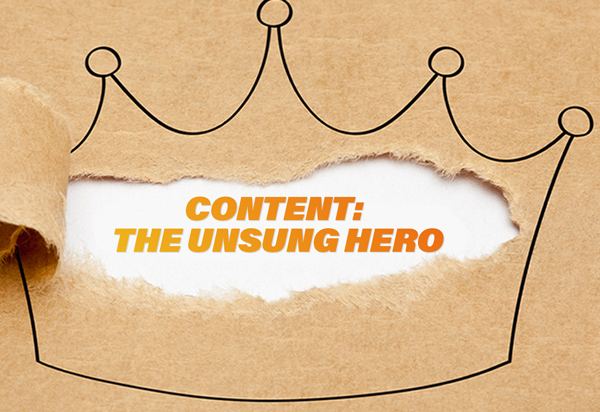




By Glenn Landauer
VP Customer Experience
How often are we told about the next big idea?
The bold creative campaign that will help you stand out in an exceedingly noisy market. Something powerful enough to stop prospects in their tracks and unapologetically demand their attention?
The answer is a lot. And rightly so. After all, if your customers didn’t know you existed, how would they know you had the perfect solution for them?
But shiny, attention-grabbing creative is only the start—the tip of the proverbial iceberg. Because once attention has been hooked, that’s when the hard work really begins: the job of sustaining and nurturing your audience’s interest through their path to purchase.

Too often we confound the customer experience with the marketing funnel. This is a grave misstep because it muddles customer and commercial priorities, each of which are in service to entirely different stakeholders. It also leads to a false narrative: the idea that there are three stops on the CX journey (ToFu, MoFu and BoFu need to be written out as top of the funnel, middle of the funnel, and bottom of the funnel) and they are somehow equal in size, duration, or influence.
The reality is very different. The top of the funnel (awareness) and the bottom of the funnel (purchase) merely represent the outer edges of a complex and multifaceted journey that, by and large, takes place in the middle. Think of ToFu and BoFu as “bookends” to a rich and layered story, with chapters that unfold over a period of weeks, or even months.
The middle of the funnel plays host to an ensemble of mission-critical activities that will ultimately determine success. Everything from interest and consideration to evaluation and decision takes place here. It’s where momentum slows, or momentum accelerates. Where opportunities are developed, or opportunities are squandered.
If the middle of the funnel is so important and much of the hard work happens here, it’s an odd phenomenon that we tend to forget about it.
Let’s remember: a B2B purchase is a highly considered decision. It takes time. It involves several stakeholders—and your company could be one of many under consideration.
There are lots of reasons why the path to purchase is a lengthy one, and it’s critical your company stays in the conversation. So how do you keep prospects tuned in for the long-haul that is the middle of the funnel?
Spoiler alert: It’s not more retargeting ads.

Want to know how to lose the attention you toiled so hard to win? Continually retargeting your audience with ads designed to do little more than say “Hey, look at me.” Right now you’re at the point when you must give customers what they need, rather than simply grabbing the latest opportunity to tell them what you want to say.
Why? Because by having won their attention in the first place, you’ve entered into an unspoken—and unwritten—contract. The customer has tacitly agreed to participate in your dialogue, but only as long as you give them something of value in return. Sure, they appreciate you have your marketing objectives and that you’d love them to choose your product or service above any others they’re considering. But if they are to engage with you, they need to know you understand their objectives, and that you’re able to provide them with what they need.
It’s a balancing act. You need to provide value (or even exceed their expectations) while being mindful of any commercial dynamics at play. And they will need to take their time.
So what’s the key to keeping customers engaged? You guessed it…

Who cares if content marketing has been around for some time now? So few marketers truly understand its power—which means there’s still an opportunity to unlock value if you can do it to an exceptional standard.
Content is, by definition, an exercise in modern marketing. Whereas traditional advertising is brand-led and attention is purchased, content is customer-led and attention must be earned.
A good content strategy is based on building relationships. It’s not about churning out endless blogs and merely hoping a small portion of your output resonates. When your content strategy focuses on developing relationships with your prospects, what you’re doing is building the strongest possible foundation for conversations that are ultimately followed by conversion.

Do your research. Take time and put in the effort to understand your prospect’s business, their role, their challenges—then talk to them in that context. CMOs and CIOs will face wildly different challenges, even if they’re from the same organization, so endeavor to genuinely understand their perspectives. It’s a bit like dating: You need to get to know each other better before you can tell if you’re the perfect match.
Moreover, it’s not about steering them through the funnel in a linear fashion. There’s potentially a whole lot they need to know, so give your audience the opportunity to self-select, and move at their own pace. Give them insights they simply can’t get anywhere else. That means no rehashing or recycling your content, no matter how tempting or easy it is to do—it won’t pay you any dividends in the long run (or even in the short run). Think original, quality content, created specifically with your audience’s individual needs in mind.

Equally, of course, you don’t need to reinvent the wheel every time. For example, what insights do you already have that you’re not using to their full potential?
One of my personal favorite projects was a series of eBooks we created for our client, ServiceNow, outlining valuable insights we’d unlocked from existing research. Each eBook analyzed a handful of macro trends in considerable depth, but rather than present generic conclusions to a very broad audience, the eBooks comprised multiple chapters, each tailored to a specific persona within the buying committee. The analysis explained the implications of each trend for each persona, then followed up by elucidating the various strategic opportunities and providing paths forward. In this way, customers could select the chapters relevant to them, and visualize not just the trends but also how the trends might affect them.
But remember, your objective is to make a sale at the end of the day—so be sure your content doesn’t lead to dead ends. Always have somewhere to take the conversation. And if the feedback you get has an opposing view to that which you published, use it as an opportunity to talk! This is a two-way street, and the goal on both sides is to foster a productive conversation and reach a mutually beneficial destination.

The idea that “content is king” has been lauded for some time now, so it’s shocking how few organizations are currently getting it right. Most default to playing a familiar volume game: using the “spray and pray” model to cast a wide enough net to gain a lot of inexpensive online impressions. Except all that achieves is generating a whole lot of cold and useless leads.
The truth is, content is still the unsung hero. And content does not win until it’s high-quality, useful, relevant, and contextualized. Marketers should be focused on producing more exceptional content tailored to the audiences they care about, and it should resonate with that audience’s challenges and help them meet their buying objectives.
A great modern content strategy achieves two goals: it establishes trust and facilitates engagement in the short term, and it creates a strong foundation for conversion in the future.
If we want different results, we need a different approach.
Let’s heed our own advice and make content king again.